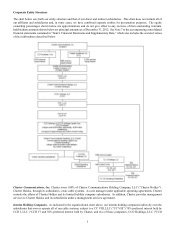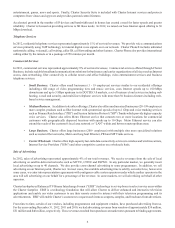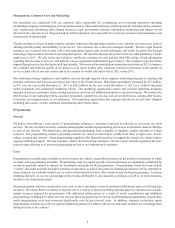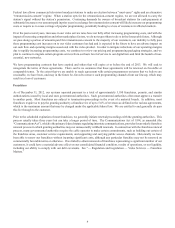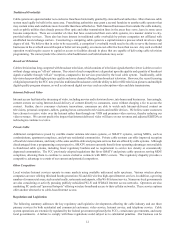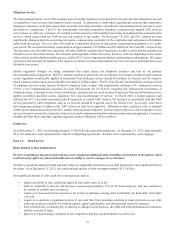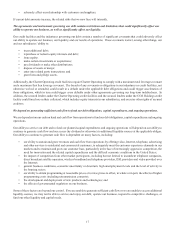Charter 2012 Annual Report Download - page 20
Download and view the complete annual report
Please find page 20 of the 2012 Charter annual report below. You can navigate through the pages in the report by either clicking on the pages listed below, or by using the keyword search tool below to find specific information within the annual report.8
Management, Customer Care and Marketing
Our operations are centralized with our corporate office responsible for coordinating and overseeing operations including
establishing company-wide strategies, policies and procedures. Sales and marketing, network operations, field operations, customer
care, engineering, advertising sales, human resources, legal, government relations, information technology and finance are all
directed at the corporate level. Regional and local field operations are responsible for servicing customers and maintenance and
construction of outside plant.
Charter continues to focus on improving the customer experience through improvements to our customer care processes, product
offerings and the quality and reliability of our service. Our customer care centers are managed centrally. We have eight internal
customer care locations which route calls to the appropriate agents, plus several third-party call center locations that through
technology and procedures function as an integrated system. We intend to increase the portion of service calls handled by Charter
employees in 2013. We also utilize our website to enable our customers to view and pay their bills online, obtain information
regarding their account or services, and perform various equipment troubleshooting procedures. Our customers may also obtain
support through our on-line chat and e-mail functionality. We increased our outside plant maintenance activities in 2012 to improve
the reliability and technical quality of our plant to avoid repeat trouble calls, which has resulted in reductions in the number of
service-related calls to our care centers and in the number of trouble call truck rolls in 2012 versus 2011.
Our marketing strategy emphasizes our bundled services through targeted direct response marketing programs to existing and
potential customers and increases awareness and value of the Charter brand. Marketing expenditures increased by $35 million,
or 9%, over the year ended December 31, 2011 to $422 million for the year ended December 31, 2012 as a result of increased
media investment and commercial marketing efforts. Our marketing organization creates and executes marketing programs
intended to increase customers, retain existing customers and cross-sell additional products to current customers. We monitor the
effectiveness of our marketing efforts, customer perception, competition, pricing, and service preferences, among other factors,
to increase our responsiveness to our customers. Our marketing organization also manages and directs several sales channels
including direct sales, on-line, outbound telemarketing and Charter stores.
Programming
General
We believe that offering a wide variety of programming influences a customer’s decision to subscribe to and retain our cable
services. We rely on market research, customer demographics and local programming preferences to determine channel offerings
in each of our markets. We obtain basic and premium programming from a number of suppliers, usually pursuant to written
contracts. Our programming contracts generally continue for a fixed period of time, usually from three to eight years, and are
subject to negotiated renewal. Some programming suppliers offer financial incentives to support the launch of a channel and/or
ongoing marketing support. We also negotiate volume discount pricing structures. We have more recently negotiated for more
content rights allowing us to provide programming on-line to our authenticated customers.
Costs
Programming is usually made available to us for a license fee, which is generally paid based on the number of customers to whom
we make such programming available. Programming costs are usually payable each month based on calculations performed by
us and are generally subject to annual cost escalations and audits by the programmers. Programming license fees may include
“volume” discounts available for higher numbers of customers, as well as discounts for channel placement or service penetration.
Some channels are available without cost to us for a limited period of time, after which we pay for the programming. For home
shopping channels, we receive a percentage of the revenue attributable to our customers’ purchases, as well as, in some instances,
incentives for channel placement.
Our programming costs have increased in every year we have operated in excess of customary inflationary and cost-of-living type
increases. We expect them to continue to increase due to a variety of factors including amounts paid for retransmission consent,
annual increases imposed by programmers with additional selling power as a result of media consolidation and additional
programming, including new sports services and non-linear programming for on-line and OnDemand programming. In particular,
sports programming costs have increased significantly over the past several years. In addition, contracts to purchase sports
programming sometimes provide for optional additional games to be added to the service and made available on a surcharge basis
during the term of the contract.







